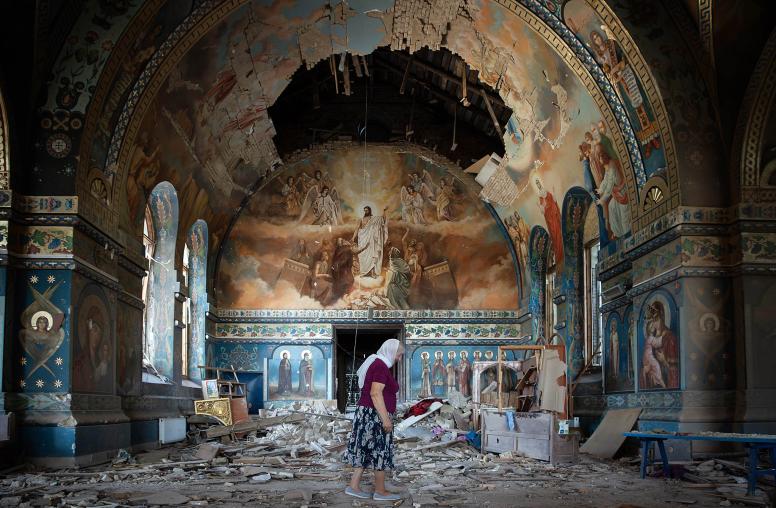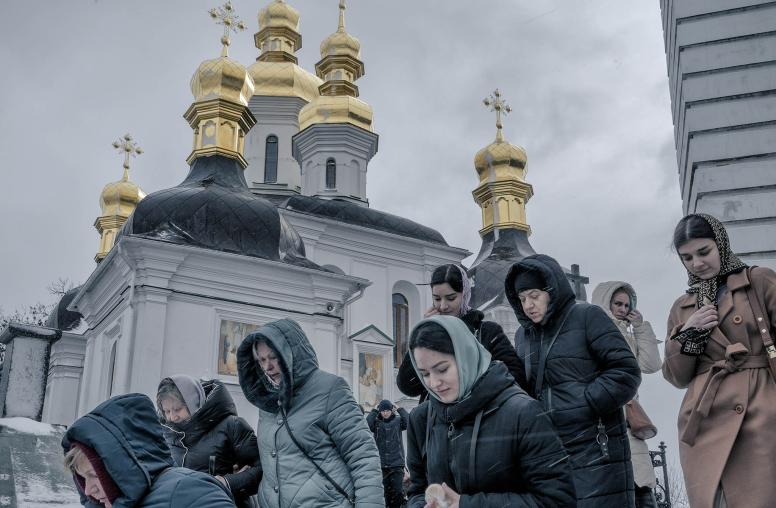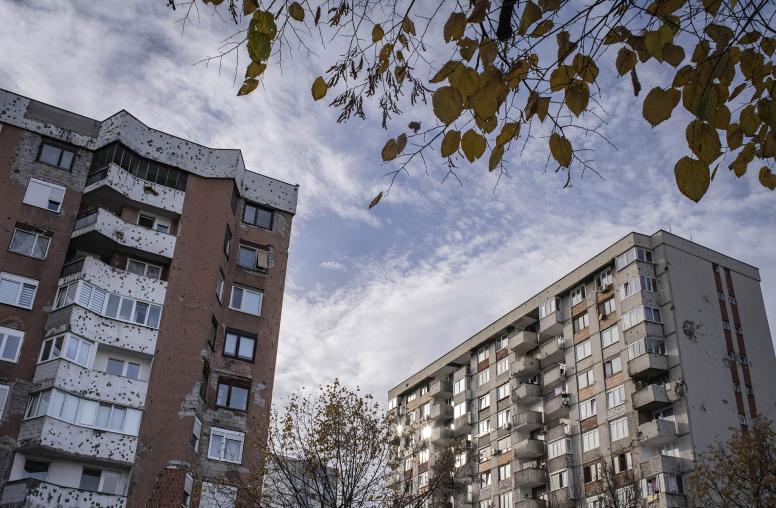What Happens When You Replace a Just War With a Just Peace
Can the Catholic Church put an end to centuries of sanctioning war, and start promoting peace instead.
In April, at the invitation of the Vatican, some 85 theologians, priests, bishops, religious sisters, and nonviolent activists (including representatives of the RECONCILE Peace Institute, Kairos Palestine, and the American Friends Service Committee) gathered at a modest retreat house on the outskirts of Rome with an unprecedented agenda: to challenge the Catholic Church’s doctrine of “just war.”
Developed in the fifth century A.D. by St. Augustine, the doctrine empowers rulers to wage war only as a last resort to confront grave wrongs. As he wrote: “Peace should be the object of your desire; war should be waged only as a necessity.” Later, the Summa Theologica, written by St. Thomas Aquinas in the 1260s and 1270s, clarified that war could only be waged by a properly instituted authority like the state, that it could not occur for purposes of self-gain, and that attaining peace must be its central aim.
Though the Catholic Church’s “just war” doctrine has been modified over the centuries — accounting for things like new technologies and the changing nature of warfare — its basic principles remain the same. As the 1992 Catechism of the Catholic Church describes, in order for the church to sanction engaging in a war, “the damage inflicted by the aggressor on the nation or community of nations must be lasting, grave, and certain; all other means of putting an end to [the conflict] must have been shown to be impractical or ineffective; there must be serious prospects of success; [and] the use of arms must not produce evils and disorders graver than the evil to be eliminated.”
But it seems that Pope Francis — who is by all accounts a progressive thinker, unafraid to challenge old church doctrines — might welcome a debate over the church’s foundational tenets on war and peace. “Faith and violence are incompatible,” he repeated in a 2013 mass prayer gathering at the Vatican. Like his predecessors of the past 50 years, he has called for the abolition of war. But this pontiff has gone one step further in pressing for nonviolent alternatives. In his letter to the Rome conference, he exhorted participants to revitalize the tools of “active nonviolence.” It was a call, in other words, to challenge the idea of “just war” and to propose an alternative paradigm.
The concept of “just peace” is not new. It first emerged in the United States in the mid-1980s, when an interdenominational group of Christian scholars advanced alternatives to war that culminated in a just-peace framework. It included practices like supporting nonviolent direct action; cooperative conflict resolution; advancing democracy, human rights, and religious liberty; fostering just and sustainable economic development; and encouraging grassroots peacemaking groups and voluntary associations. The inter-religious dialogue expanded to include Jewish and Islamic traditions, focusing on the scriptural and practical meanings of “just peace” in the three Abrahamic traditions. The scholarly dialogue resulted in the creation of an Abrahamic framing of an interfaith just-peacemaking paradigm that was later published in book form.
Given the power of modern warfare, and the second- and third-order effects of unleashing conflicts (even for presumably “just” causes), many participants at the Rome conference came seeking a bold new direction for the church. The fact that most came from contexts of extreme violence and injustice in Africa, the Americas, Asia, Europe, and the Middle East made the conversations all the more visceral and meaningful.
For some at the Rome conference, the pope’s endorsement of the gathering was long overdue for the church. Many of those in attendance, like Sister Nazek Matty from Erbil, Iraq, had known war for years and were sick of it. She and other participants pressed the church to place greater focus on nonmilitary responses to the Islamic State and expand the creative imagination to fight injustices with active nonviolent means. During one of the plenary sessions, Rev. Francisco José de Roux, a Jesuit priest from Colombia, decried how, since the mid-1960s, supporters of both the government and FARC insurgents, including local priests, have justified violence in the name of a “just war.” The outcome? Nearly 50 years of civil war. Other Catholic leaders in Colombia have supported nonviolent civic action and “zones of peace” to keep armed groups out of local communities and have helped advance peace talks expected to culminate in a final settlement later this year. By putting a just-peace approach at the center of its work, the Catholic Church in Colombia opened multiple avenues to effective nonviolent action.
One key exchange at the conference illustrated how just peace could make a big difference. Ugandan Archbishop John Baptist Odama of Gulu described how, after a round of bloody tit-for-tat killings in the government’s long-running war against Joseph Kony’s Lord’s Resistance Army, an inter-religious group won the trust of the two sides and employed effective shuttle diplomacy to stop the violence. The group helped mediate a cease-fire between the two sides, showing that nonviolent tools can open channels of communication and produce results even in the fight against extremism.
If dialogue and mediation are two critical skills in a just-peace arsenal, so, too, is nonviolent resistance, whose tactics include marches, boycotts, and strikes. Jean-Marie Muller, the French leader of the Movement for a Nonviolent Alternative, described how nonviolent action through history has laid the necessary groundwork for successful negotiations between conflicting parties. He cited Martin Luther King Jr.’s Letter From a Birmingham Jail, which highlighted the complementary nature of dialogue and direct action. Pietro Ameglio, a Uruguayan activist working with SERPAJ México, a human rights organization, insisted during the conference that only “organized civil disobedience” would sufficiently pressure drug lords and government authorities to stop rampant abuses in Mexico. Responding to the participants’ demands for solutions, the final document produced by the conference called on the church to “promote nonviolent practices and strategies,” including “nonviolent resistance, restorative justice, trauma healing, unarmed civilian protection, conflict transformation, and peacebuilding strategies.” As envisioned in the document, these approaches could then be integrated at all levels — in churches, universities, and field-based activities.
Advocates of a shift from just war to just peace will inevitably be confronted with tough cases, like what to do about the Islamic State. Although no pope since the 1960s has invoked just-war criteria to defend a war, what church leaders say about the use of military force carries weight. When Archbishop Silvano Tomasi, the Holy See’s ambassador to the U.N. in Geneva, said in 2015 that force is necessary to protect minorities against genocide at the hands of the Islamic State, it was considered an “unusually blunt” statement. Similarly, Pope Benedict XVI’s strong endorsement of the responsibility to protect (R2P) — the 2005 U.N. General Assembly resolution that permits international military intervention in instances of genocide and crimes against humanity — was significant. However, the U.S. Conference of Catholic Bishops refused to support military action in Libya on R2P grounds, a sign that the church is hardly a monolithic, single-minded organization on critical issues.
While one could argue that the just-war doctrine helps policymakers and ordinary citizens navigate the most difficult situations, many at the Vatican conference disagreed, arguing instead that the emphasis on just war limited the potential for creative alternatives to violence. Cardinal Peter Turkson, the president of the Pontifical Council for Justice and Peace, one of the two co-conveners of the conference along with Pax Christi International, a peace-building organization, expressed concern that just war has too often been used to rationalize wars that produce more harm than good. Marie Dennis, co-president of Pax Christi, similarly noted that just war has been “used and abused by political leaders.”
The reality is that just peace has long been a potent force in the church’s history, despite the prevailing power of just war. The conference should build on this very real legacy. To be sure, the Roman Catholic Church has, at times, sided with dictatorships and other repressive regimes. But Catholic leaders and institutions have also stood on the front lines of a number of nonviolent struggles for peace and dignity. Pope John Paul II sided firmly with the Polish Solidarity movement during its nonviolent resistance to communist dictatorship in the 1980s. When East Timor, vying for self-determination and independence from Indonesia, challenged its brutal occupation nonviolently and was met with violence, church leaders vocally denounced Jakarta’s human right abuses.
The church was boldest in its support for nonviolent resistance against Ferdinand Marcos’s dictatorship in the Philippines in the 1980s. Although a rebel force, the New People’s Army attempted to topple Marcos’s corrupt and oppressive regime with violence; church leaders, by contrast, insisted on unarmed resistance. As two of the Rome conference organizers, Revs. John Dear and Ken Butigan, noted, in this case rhetoric was backed by action. First, the International Fellowship of Reconciliation, an ecumenical Christian organization dedicated to nonviolent social change, led dozens of nonviolent action workshops across the Philippines. After attending a workshop, Cardinal Jaime Sin, the highest-ranking Catholic official in the country, joined the Catholic Bishops’ Conference of the Philippines in calling for a “nonviolent struggle for justice.” These trainings, along with a sophisticated election-monitoring mission led by nuns and priests, paved the way for the mass “people power” movement that prevented Marcos from stealing the 1986 presidential elections. More than a million unarmed Filipinos, together with units of the military that refused orders to shoot at the peaceful protestors, challenged violence with nonviolent resistance and won.
To take its work on “just peace” to the next, practical level, the church should prioritize investment in teaching and training that brings together these dialogical and action-oriented nonviolent approaches. Empirical evidence that nonviolent resistance is overwhelmingly more effective than armed struggle was already cited in the conference’s final document. While the conference cited Pope Francis’s massive prayer vigil in St. Peter’s Square in September 2013 to condemn military action in Syria, what if the church galvanized similar support for those Syrians (including Christians) who have, since March 2011, been committed to nonviolently challenging both dictatorship and violent extremism?
But it can also begin the hard work of forcing political leaders to consider new options — now. Rather than getting bogged down in debates over whether military force to save the Yazidis is justified (a debate that would likely prove to be unnecessarily divisive), the church should call for nonviolent, nonmilitary options to confront violent extremism. For example, there are numerous ways to erode or undermine the moral and material power of the Islamic State, Boko Haram in Nigeria, and al-Shabab in Kenya and the Horn of Africa that don’t involve military strikes. Amplifying the voices of defectors, financially supporting local self-organization, investing in strategic satire, and transferring knowledge and skills about how organized nonviolent resistance targeting these groups has won small victories in Syria, Iraq, and Kenya are only a few nonmilitary tools.
The church should work with academics and practitioners to establish a firm evidence base for these nonmilitary interventions and then advocate for them locally, regionally, and internationally. That would be a concrete way to put meat on the bones of “just peace” while mainstreaming the principles, tools, and approaches at all levels of the church — from the Vatican to national bishops’ conferences to dioceses and local parishes. Catholic universities and peace-building organizations like Pax Christi, Mercy Corps, Caritas International, and Catholic Relief Services are well-placed to integrate dialogue with nonviolent collective action approaches in their education and field operations. They could ally with umbrella organizations like the Alliance for Peacebuilding, plus nonviolent action and movement-building organizations like Rhize and the International Center on Nonviolent Conflict, and civilian protection organizations like Nonviolent Peaceforce that are advancing effective nonmilitary solutions on the ground. If the church joined forces with other Christian denominations, along with Muslim and Jewish leaders and institutions, to prioritize areas of collaboration focused on Abrahamic peacemaking, the effect would be even more powerful.
One doesn’t need to be Catholic or even a religious person to appreciate what went down in Rome. But now, the sense of grassroots urgency needs to be channeled into focused planning and coalition building in order to shift resources and give just peace a fighting chance.
Reposted with permission from ForeignPolicy.com, Source: “What Happens When You Replace a Just War With a Just Peace"



